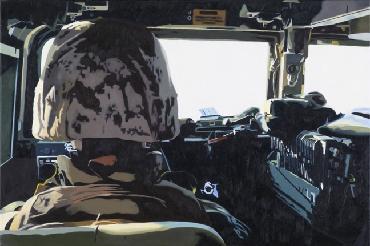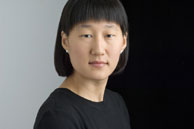MCAD/Jerome Artists 2005-06: Megan Rye
Essays by Kristin Makholm, MCAD Gallery Director and Program Director, MCAD/Jerome Foundation Fellowships for Emerging Artists


Megan Rye
When the Jerome jury first saw Megan Rye’s work in the slide screening of October 2005, they viewed photo-realist paintings of Tokyo fish markets, their interiors awash in color and light: a banquet for the senses under raking fluorescent bulbs. She had infused these mundane, albeit exotic, scenes with such seductive candor, breathing life into their slime-drenched surfaces and frenzied chaos with a lush, uncompromising beauty. Her vivid colors and slick surfaces were beguiling, even as the sickly light hinted at a darker subtext of alienation, anxiety and loneliness.
Fast forward a few days to the jury’s studio visit, when Rye notched up this intensity with a daring, last-minute addition: a half-completed painting of a bomb scene on a U.S. military base in Mosul, Iraq. The painting was inspired by a news photo taken in the aftermath of a December 2004 explosion at a mess tent that left more than 20 dead. As stark light streams through the torn burlap tent, investigators pick through rubble
that includes not only food, but also human remains. Like a Rorschach inkblot, Rye doubles the scene out from the apex of the tent, creating an ethereal, chapel-like interior, or what she self-reflexively calls a “theater of violence.”
Mosul Iraq, 12.21.04 became the vanguard of a series of paintings that Rye now considers a full-blown obsession, a project known as Iraq War, Aftermath of Violence. It is, vicariously, a deeply personal inquiry. In August 2004, Rye’s younger brother, Ryan Rye Nosek, was deployed in Iraq as a U.S. Marine, where he supervised the regional detention facility in Fallujah and ran convoys for detainee operations within the Sunni Triangle until his return home in March 2005. During these months, he took approximately 2,000 photographs, which he entrusted to his sister. The photographs have inspired Rye’s paintings ever since.
Rye’s images of surveillance and aggression are conduits into the military experience and, more immediately, into her brother’s soul. Be it a picture of Iraqi detainees huddled under colorful blankets
on the bed of an Army truck or the back of a Marine as he drives a Humvee into nothingness, Rye situates the fear and vulnerability of this prolonged engagement through strategies of painting, challenging what it means to be a witness to the unabated tension and tedium of war. Like our compulsion to know and see more of the horrors unfolding in the Middle East, the paintings seduce even as we realize the banality of a soldier’s daily routine and the brutal inequities of occupation. Then we are confronted with questions of why we are there and why, indeed, we fight at all. (K.M.)